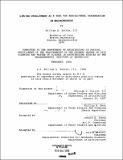| dc.contributor.advisor | Phillip B. Herr. | en_US |
| dc.contributor.author | Tuttle, William D. (William Davis) | en_US |
| dc.contributor.other | Massachusetts Institute of Technology. Dept. of Urban Studies and Planning. | en_US |
| dc.coverage.spatial | n-us-ma | en_US |
| dc.date.accessioned | 2013-03-28T18:00:44Z | |
| dc.date.available | 2013-03-28T18:00:44Z | |
| dc.date.copyright | 1988 | en_US |
| dc.date.issued | 1988 | en_US |
| dc.identifier.uri | http://hdl.handle.net/1721.1/78081 | |
| dc.description | Thesis (M.S.)--Massachusetts Institute of Technology, Dept. of Architecture; and, (M.C.P.)--Massachusetts Institute of Technology, Dept. of Urban Studies and Planning, 1988. | en_US |
| dc.description | Includes bibliographical references (leaves 192-197). | en_US |
| dc.description.abstract | Limited development offers the hope of turning market development pressure which threatens open land into a means for financing its protection. In theory, the profit from developing a small portion of a parcel can be used to subsidize the protection of the remainder. This thesis critically examines the financial, institutional, and agricultural effectiveness of limited development as a tool for protecting farmland. An alternative accounting methodology is proposed which expresses cash flows as sources and uses of subsidies for the support of non-market land uses, allowing comparison of limited development and traditional tools for financing land conservation. The model also attempts to determine the extent to which limited development profits are due to enhancement of development land value by the restriction of adjacent open space, market appreciation in real estate prices, and deal-making and subdivision of land. The model assumes the perspective of a non-profit limited developer. The model is then applied to three Massachusetts case studies of farmland preservation through limited development. The agricultural viability of the protected farmland is briefly examined in each case study. The thesis concludes that limited development often provides only a minor supplement to public subsidy programs and private contributions in the protection of farmland, although it can supply significant subsidies in some cases. Furthermore, limited development can put a non-profit into the awkward and risky role of a for-profit developer. Agriculturally, limited development leaves small farm parcels adjacent to residential use. While not ideal, such a pattern is typical of metropolitan areas, and one to which some farmers have successfully adapted. | en_US |
| dc.description.statementofresponsibility | by William D. Tuttle, III. | en_US |
| dc.format.extent | v, 267 leaves | en_US |
| dc.language.iso | eng | en_US |
| dc.publisher | Massachusetts Institute of Technology | en_US |
| dc.rights | M.I.T. theses are protected by
copyright. They may be viewed from this source for any purpose, but
reproduction or distribution in any format is prohibited without written
permission. See provided URL for inquiries about permission. | en_US |
| dc.rights.uri | http://dspace.mit.edu/handle/1721.1/7582 | en_US |
| dc.subject | Architecture. | en_US |
| dc.subject | Urban Studies and Planning. | en_US |
| dc.title | Limited development as a tool for agricultural preservation in Massachusetts | en_US |
| dc.type | Thesis | en_US |
| dc.description.degree | M.C.P. | en_US |
| dc.description.degree | M.S. | en_US |
| dc.contributor.department | Massachusetts Institute of Technology. Department of Architecture | |
| dc.contributor.department | Massachusetts Institute of Technology. Department of Urban Studies and Planning | |
| dc.identifier.oclc | 18369039 | en_US |
